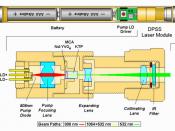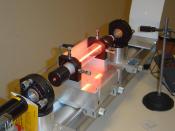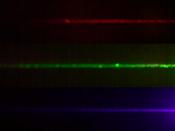Refracting Lasers?
Lasers are very important in our world today; but not too long ago, we did not have them! The main reason they did not think of them before the 1900's was because scientists did not know about stimulated emission. But in the early 1900's Albert Einstein was the first to describe this process. The next major breakthrough in lasers was when Charles H. Townes created a population inversion, which is needed to create stimulated emission in an instrument that amplified microwaves called a maser in 1954. The 1950's was when the basic laser started to take shape. Many men like Townes, Arthur L. Schawlow, Alexander M. Prokhorov, Nicolai G. Basov, and Gordan Gould all contributed to the basic design. The one person who did finally invent the first laser was Theodore H. Maiman of the United States in 1960. Maiman's laser used a ruby rod as its active medium (World Book Millennium, 2000, p.
86). It was so bright that it "outshone" the sun (Olesky, 1986). Not to long after, in the same year, Ali Javan, an American physicist, constructed the first working gas laser. Then in 1962 three separate teams of U.S. scientists operated the first semiconductor lasers. Subsequently, in 1966, the American physicist Peter Sorokin built the first working dye laser. Of course there have been other smaller advances since then too (World Book Millennium, 2000, p. 86). So down to the problem that needs to be answered. Will a laser refract if it goes through a prism?
First to understand a laser you need to know that there are two kinds of light. One is ordinary light, an example is white light, and there is coherent light, an example of that is laser light. Ordinary light is light that comes from things like the...


